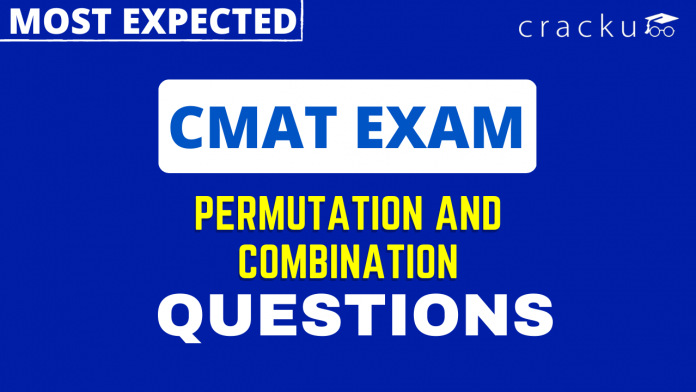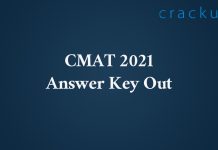CMAT Permutation and Combination Questions [Download PDF]
Download CMAT Permutation and Combination questions with solutions PDF by Cracku. Practice CMAT solved Permutation and Combination Questions paper tests, which are the practice question to have a firm grasp on the Permutation and Combination topic in the CMAT exam. Top 20 very Important Permutation and Combination Questions for CMAT based on the questions asked in previous exam papers. Click on the link below to download the Permutation and Combination Questions for CMAT PDF with detailed solutions.
Download Permutation and Combination Questions for CMAT
Enroll to CMAT 2023 Crash Course
Question 1: Letters of the word DIRECTOR are arranged in such a way that all the vowel come together .Find the No of ways making such arrangement?
a) 4320
b) 720
c) 2160
d) 120
e) None of these
1) Answer (A)
Solution:
Word – DIRECTOR
So “I,E,O” are there are 3! ways to arrange the vowels
Now “D,R,C,T,R” are the remaining alphabets ,
Condition is that the vowels should always be together so we can assume the vowels as a single alphabet/unit say “X” (‘X’=’I,E,O’) so now we have a new word – “D,R,C,T,R,X”
Possible arrangements for this word = 6!
Thus total number of ways to rearrange DIRECTOR with vowels grouped together = (Possible arrangements of ‘DRCTRX’) $\times$ (Possible arrangements of vowels)
= 6! $\times$ 3! = $720 \times 6 = 4320$
=> Ans – (A)
Question 2: In a box carrying one dozen of oranges one third have become bad.If 3 oranges taken out from the box random ,what is the probability that at least one orange out of the 3 oranges picked up is good ?
a) 1/55
b) 54/55
c) 45/55
d) 3/55
e) None of these
2) Answer (B)
Solution:
Total number of oranges in the box = 12
Number of ways of selecting 3 oranges out of 12 oranges, n(S) = $C^{12}_3$
= $\frac{12 \times 11 \times 10}{1 \times 2 \times 3} = 220$
Number of oranges which became bad = $\frac{12}{3}=4$
Number of ways of selecting 3 oranges out of 4 bad oranges = $C^4_3 = C^4_1 = 4$
Number of desired selection of oranges, n(E) = 220 – 4 = 216
$\therefore$ $P(E) = \frac{n(E)}{n(S)}$
= $\frac{216}{220}= \frac{54}{55}$
=> Ans – (B)
Question 3: In how many different ways can the letters of the word TRUST’ be arranged?
a) 240
b) 120
c) 80
d) 25
e) None of these
3) Answer (E)
Solution:
Word = ‘TRUST’
There are 5 letters and ‘T’ is repeated.
If there are ‘n’ letters and ‘r’ are repeating, then number of ways of arranging them = $\frac{n !}{r !}$
$\therefore$ Number of ways in which letters of the word ‘TRUST’ can be arranged
= $\frac{5 !}{2 !} = \frac{5 \times 4 \times 3 \times 2 \times 1}{2 \times 1}$
= $5 \times 4 \times 3 = 60$
=> Ans – (E)
Question 4: How many such pairs of letters are there in the word FOREHAND each of which have as many letters between them in the word as they have in the English alphabet?
a) None
b) One
c) Two
d) Three
e) More than three
4) Answer (C)
Solution:
Word = FOREHAND
There are 2 pairs of letters which have as many letters between them in the word as they have in the English alphabet
FA and RN
Question 5: If it is possible to make only one meaningful word from the second, the fourth, the sixth and the ninth letters of the word PROACTIVE, using each letter only once, second letter of that word is your answer. If more than one word can be formed your answer is M and if no such word can be formed your answer is N.
a) A
b) E
c) T
d) M
e) N
5) Answer (D)
Solution:
Word = PROACTIVE
2nd, 4th, 6th and 9th letters = R, A, T, E
No. of words that can be formed by using (R,A,T,E)
= Rate , Tear
Since only 2 words are formed
=> Ans = M
Question 6: In how many different ways can the letters of the word DRASTIC be arranged in such a way that the vowels always come together ?
a) 720
b) 360
c) 1440
d) 540
e) None of these
6) Answer (C)
Solution:
There are 7 letters in the word ‘DRASTIC’ including 2 vowels (A,I) and 5 consonants (D,R,S,T,C).
Considering the two vowels as 1 letter, we have 6 letters which can be arranged in 6! ways
But corresponding to each way of these arrangements, the vowels can be put together in 2! ways.
Hence, required number of words = $6! \times 2!$
= 720 * 2 = 1440
Question 7: Which of the following set of fractions is in ascending order ?
a) 13/15, 11/13, 7/8, 8/9
b) 11/13, 13/15, 7/8, 8/9
c) 8/9, 7/8, 13/15, 11/13
d) 7/8, 8/9, 11/13, 13/15
e) None of these
7) Answer (B)
Solution:
Decimal equivalent of :
$\frac{13}{15} = 0.87$
$\frac{11}{13} = 0.85$
$\frac{7}{8} = 0.875$
$\frac{8}{9} = 0.89$
Clearly, 0.85 < 0.87 < 0.875 < 0.89
=> $\frac{11}{13} < \frac{13}{15} < \frac{7}{8} < \frac{8}{9}$
Question 8: Certain number of pieces of an article are to be packed in boxes, such that each box contains 145 pieces. If after packing them in 32 boxes 25 pieces are left out, what was the number of pieces to be packed ?
a) 4566
b) 4655
c) 4465
d) 4640
e) None of these
8) Answer (E)
Solution:
No. of pieces
= 32 * 145 + 25
= 4640 + 25 = 4665
Question 9: In how many different ways can the letters of the word ‘HAPPY’ be arranged ?
a) 120
b) 140
c) 60
d) 70
e) None of these
9) Answer (C)
Solution:
The word HAPPY contains 5 letters in which letter ‘P’ comes twice.
=> Number of arrangements = $\frac{5!}{2!}$
= $\frac{120}{2} = 60$
Question 10: In how many different ways can the letters of the word ‘FRANCE’ be arranged ?
a) 2400
b) 720
c) 2005
d) 5040
e) None of these
10) Answer (B)
Solution:
The word FRANCE consists of 6 distinct letters
=> Required number of arrangements = 6!
= 720
Question 11: In how many different ways can the letters of the word ‘CREAM’ be arranged?
a) 720
b) 240
c) 360
d) 504
e) None of these
11) Answer (E)
Solution:
The word CREAM consists of five distinct letters
=> No. of ways the letters will be arranged = $5!$
= 120
Question 12: In how many different ways can the letters of the word “ARISE’ be arranged?
a) 90
b) 60
c) 180
d) 120
e) None of these
12) Answer (D)
Solution:
The word ‘ARISE’ has 5 different letters
=> Required number of arrangements = $5!$
= $5 \times 4 \times 3 \times 2 \times 1 = 120$
Question 13: In how many different ways can the letters of the world ‘SECOND’ be arranged?
a) 720
b) 120
c) 5040
d) 270
e) None of these
13) Answer (A)
Solution:
The word ‘SECOND’ has 6 different letters
=> Required number of arrangements = $6!$
= $6 \times 5 \times 4 \times 3 \times 2 \times 1 = 720$
Question 14: A bag A contains 4 green and 6 red balls. Another bag B contains 3 green and 4 red balls. If one
ball is drawn from each bag, and the probability that both are green.
a) 13/70
b) 1/4
c) 6/35
d) 8/35
e) None of these
14) Answer (C)
Solution:
Total balls in bag A = 4 + 6 = 10
Probability that ball is green = $\frac{4}{10}$
Total balls in bag B = 3 + 4 = 7
Probability that ball is green = $\frac{3}{7}$
=> Required probability = $\frac{4}{10} \times \frac{3}{7}$
= $\frac{6}{35}$
Question 15: A bag contains 2 red, 3 green and 2 blue balls. 2 balls are to be drawn randomly. What is the probability that the balls drawn contain no blue ball ?
a) 5/7
b) 10/21
c) 2/7
d) 11/21
e) None of these
15) Answer (B)
Solution:
Total number of balls = 2 + 3 + 2 = 7
Total number of outcomes = Drawing 2 balls out of 7
= $C^7_2 = \frac{7 \times 6}{1 \times 2} = 21$
Favourable outcomes = Drawing 2 balls out of 5 (so that none is blue)
= $C^5_2 = \frac{5 \times 4}{1 \times 2} = 10$
=> Required probability = $\frac{10}{21}$
Question 16: In how many different ways can the letters of the word “PRIDE” be arranged ?
a) 60
b) 120
c) 15
d) 360
e) None of these
16) Answer (B)
Solution:
The word ‘PRIDE’ consists of 5 distinct letters
=> Number of arrangements = $5!$
= $5 \times 4 \times 3 \times 2 \times 1 = 120$
Question 17: There are 8 brown balls, 4 orange balls and 5 black balls in a bag. Five balls are chosen at random. What is the probability of their being 2 brown balls, 1 orange ball and 2 black balls ?
a) $\frac{191}{1547}$
b) $\frac{180}{1547}$
c) $\frac{280}{1547}$
d) $\frac{189}{1547}$
e) None of these
17) Answer (C)
Solution:
Total number of balls in the bag = 8 + 4 + 5 = 17
P(S) = Total possible outcomes
= Selecting 5 balls at random out of 17
=> $P(S) = C^{17}_5 = \frac{17 \times 16 \times 15 \times 14 \times 13}{1 \times 2 \times 3 \times 4 \times 5}$
= $6188$
P(E) = Favorable outcomes
= Selecting 2 brown, 1 orange and 2 black balls.
=> $P(E) = C^8_2 \times C^4_1 \times C^5_2$
= $\frac{8 \times 7}{1 \times 2} \times 4 \times \frac{5 \times 4}{1 \times 2}$
= $28 \times 4 \times 10 = 1120$
$\therefore$ Required probability = $\frac{P(E)}{P(S)}$
= $\frac{1120}{6188} = \frac{280}{1547}$
Question 18: In a bag there are 4 white, 4 red and 2 green balls. Two balls are drawn at random. What is the probability that at least one ball is of green colour ?
a) $\frac{4}{5}$
b) $\frac{3}{5}$
c) $\frac{1}{5}$
d) $\frac{2}{5}$
e) None of these
18) Answer (D)
Solution:
There are 4 white, 4 red and 2 green balls and two balls are drawn at random.
Total possible outcomes = Selection of 2 balls out of 10 balls
= $C^{10}_2 = \frac{10 * 9}{1 * 2} = 45$
Favourable outcomes = 1 green ball and 1 ball of other colour + 2 green balls
= $C^2_1 \times C^8_1 + C^2_2$
= 2*8 + 2 = 18
$\therefore$ Required probability = $\frac{18}{45} = \frac{2}{5}$
Question 19: A bag contains 3 white balls and 2 black balls. Another bag contains 2 white and 4 black balls. A bag and a ball are picked at random. What is the probability that the ball drawn is white ?
a) $\frac{7}{11}$
b) $\frac{7}{30}$
c) $\frac{5}{11}$
d) $\frac{7}{15}$
e) $\frac{8}{15}$
19) Answer (D)
Solution:
Probability of choosing bag 1 = (1/2)
Probability of choosing bag 2 = (1/2)
Probability of choosing white ball from bag 1 = 3/5
Probability of choosing white ball from bag 2 = 2/6
Probability of choosing bag 1 and white ball from it = (1/2)(3/5) = 3/10
Probability of choosing bag 2 and white ball from it = (1/2)(2/6) = 2/12
Probability of choosing a bag and drawing a white ball = (3/10) + (2/12) = (28/60) = (7/15)
Option D is the correct answer.
Question 20: In a bag, there are 6 red balls and 9 green balls. Two balls are drawn at random, what is the probability that at least one of the balls drawn is red ?
a) 29/35
b) 7/15
c) 23/35
d) 2/5
e) 19/35
20) Answer (C)
Solution:
Probability that at least 1 ball is red = 1 – probability that none of them is red.
Probability that none if the two balls is red = (9/15)(8/14)
Probability that at least 1 ball is red = 1 – probability that none of them is red. = 1- [(9/15)(8/14)] = (210-72)/210
= 138/210
=23/35
Option C is the correct answer.





